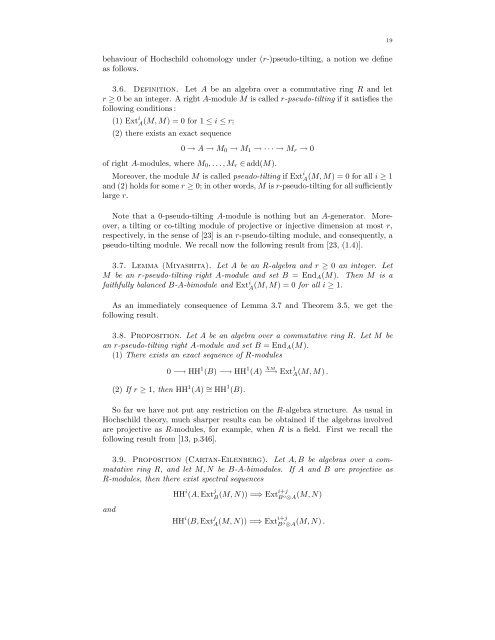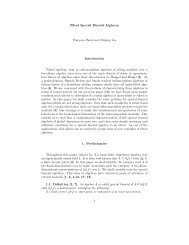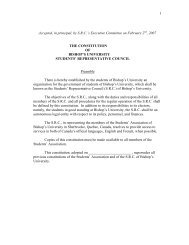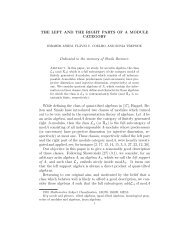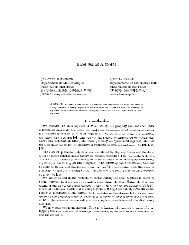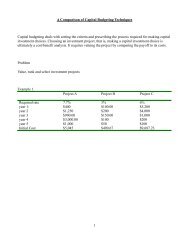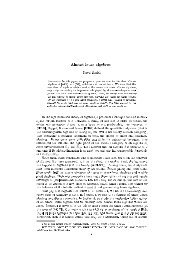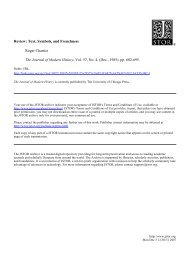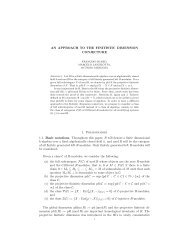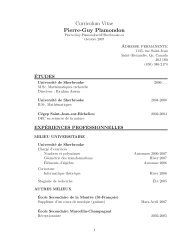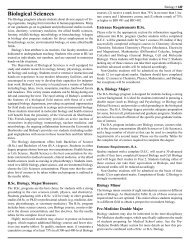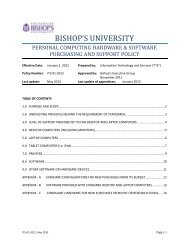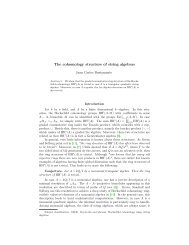Hochschild Cohomology and Representation-finite Algebras Ragnar ...
Hochschild Cohomology and Representation-finite Algebras Ragnar ...
Hochschild Cohomology and Representation-finite Algebras Ragnar ...
Create successful ePaper yourself
Turn your PDF publications into a flip-book with our unique Google optimized e-Paper software.
19<br />
behaviour of <strong>Hochschild</strong> cohomology under (r-)pseudo-tilting, a notion we define<br />
as follows.<br />
3.6. Definition. Let A be an algebra over a commutative ring R <strong>and</strong> let<br />
r ≥ 0 be an integer. A right A-module M is called r-pseudo-tilting if it satisfies the<br />
following conditions :<br />
(1) Ext i A (M,M) =0for1≤ i ≤ r;<br />
(2) there exists an exact sequence<br />
0 → A → M 0 → M 1 →···→M r → 0<br />
of right A-modules, where M 0 ,...,M r ∈ add(M).<br />
Moreover, the module M is called pseudo-tilting if Ext i A (M,M) = 0 for all i ≥ 1<br />
<strong>and</strong> (2) holds for some r ≥ 0; in other words, M is r-pseudo-tilting for all sufficiently<br />
large r.<br />
Note that a 0-pseudo-tilting A-module is nothing but an A-generator. Moreover,<br />
a tilting or co-tilting module of projective or injective dimension at most r,<br />
respectively, in the sense of [23] is an r-pseudo-tilting module, <strong>and</strong> consequently, a<br />
pseudo-tilting module. We recall now the following result from [23, (1.4)].<br />
3.7. Lemma (Miyashita). Let A be an R-algebra <strong>and</strong> r ≥ 0 an integer. Let<br />
M be an r-pseudo-tilting right A-module <strong>and</strong> set B =End A (M). Then M is a<br />
faithfully balanced B-A-bimodule <strong>and</strong> Ext i A (M,M) =0for all i ≥ 1.<br />
As an immediately consequence of Lemma 3.7 <strong>and</strong> Theorem 3.5, we get the<br />
following result.<br />
3.8. Proposition. Let A be an algebra over a commutative ring R. Let M be<br />
an r-pseudo-tilting right A-module <strong>and</strong> set B =End A (M).<br />
(1) There exists an exact sequence of R-modules<br />
0 −→ HH 1 (B) −→ HH 1 (A) −→ χM<br />
Ext 1 A(M,M) .<br />
(2) If r ≥ 1, thenHH 1 (A) ∼ = HH 1 (B).<br />
So far we have not put any restriction on the R-algebra structure. As usual in<br />
<strong>Hochschild</strong> theory, much sharper results can be obtained if the algebras involved<br />
areprojectiveasR-modules, for example, when R is a field. First we recall the<br />
following result from [13, p.346].<br />
3.9. Proposition (Cartan-Eilenberg). Let A, B be algebras over a commutative<br />
ring R, <strong>and</strong>letM,N be B-A-bimodules. If A <strong>and</strong> B are projective as<br />
R-modules, then there exist spectral sequences<br />
<strong>and</strong><br />
HH i (A, Ext j B<br />
(M,N)) =⇒ Exti+j<br />
B o ⊗A (M,N)<br />
HH i (B,Ext j A<br />
(M,N)) =⇒ Exti+j<br />
B o ⊗A (M,N) .


